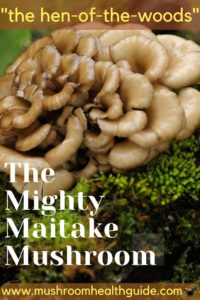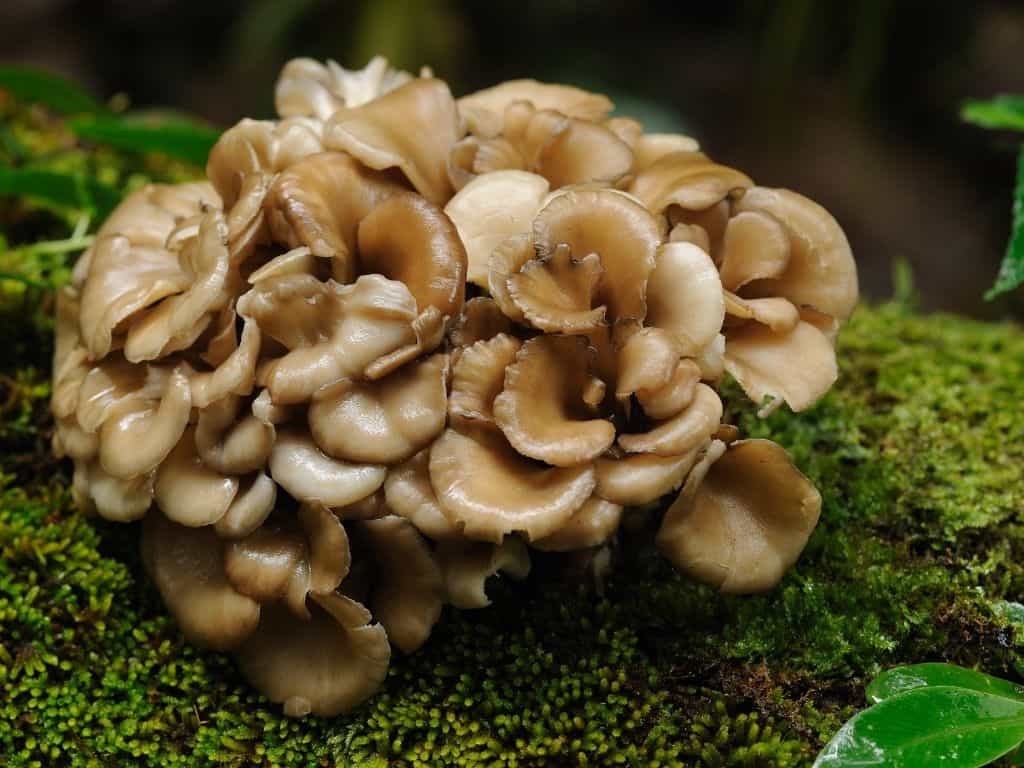It’s time to champion the little-known Maitake mushroom, Grifola frondosa, with its unique flavor and texture and its amazing health benefits.
The Maitake is one of the less common varieties of mushrooms in the Western world, but we’re finding out that it needs to be more common, and eaten more regularly. It has a long history in the East. A Japanese legend tells of a group of nuns and woodcutters who met on a mountain trail thousands of years ago. There they discovered maitake mushrooms emerging from the forest floor, and they were so elated at the discovery that they danced to celebrate.
Long touted in Japan and China for its taste and its boost to well-being, the Maitake is making itself known in the Western world too.
Let’s find out more about this powerful fungi by looking at the facts behind the Maitake.
Like This Article? Pin it on Pinterest

The Maitake Mushroom
Maitake goes by several different names, but the origin of its most common moniker is from that Japanese legend, as the name means “dancing mushroom.” “Mai” or dancing, was apparently in reference to the joy felt by those who found these fungus in the wild, combined with “take” or mushroom.
It is also known as hen-of-the-woods, the ram’s head, the sheep’s head, and in Italy the signorina mushroom.
The fruiting body grows in a cluster, with grayish-brown caps that are curled or spoon-shaped. In Japan, the maitake often grows bigger than 100 pounds, so it’s also known there as the king of mushrooms.
Maitake is popular in Japan and China, where it’s used in many different recipes. Besides their delicious taste and texture, they are also purported to give a boost to our well-being.
Nutritional Properties of Grifola frondosa
Maitake’s health benefits are derived from the nutritional properties contained within. That includes:
- Rich in Vitamin D
- Contains Vitamin C
- Offers B vitamins, niacin, riboflavin and pantothenic acid
- Rich in bioactive polysaccharides, which have immune-protecting and antitumor properties
- Also contains a high concentration of potassium along with other helpful minerals and amino acids
- Low in calories, cholesterol, sodium and fat
- Other healthy properties like fiber
As a bonus to eating Maitake, it contains L-glutamate. This natural flavor-enhancing property provides the umami taste, a savory flavor known as the fifth taste, along with sweet, sour, salty and bitter.
Perhaps you’re wondering: Do Maitake mushrooms interact with any medication? There isn’t a lot of research into long-term effects of taking Maitake mushroom extract. Some studies show a possibility of interaction with medication that lowers blood sugar, and medication that thins blood, such as warfarin.
Health Benefits of Maitake Mushrooms
Like all mushrooms, the maitake provides health advantages. Here are a few:
- Maitake has been used traditionally in Japan and China for cooking, but also to treat diabetes and hypertension. Maitake, like other medicinal mushrooms, contains beta-glucan. This complex sugar has been shown in laboratory studies to stimulate various cells and factors in the immune system, to slow the growth of certain tumors, and to lower blood sugar levels.
- Studies have shown that D‐Fraction, an extract of Maitake, exerts notable effects on the immune system.
- One study, while it was conducted on mice, provided promising results in fighting breast cancer. By administering the Maitake D‐Fraction to mice, it was able to block more than 60% of breast cancer development. The study concluded that Maitake D‐Fraction, when administered to mice, “prevents breast carcinogenesis, blocks tumor invasiveness, reduces angiogenesis, and increases overall survival.”
- Another study showed that oral administration of Maitake extract α-glucan could inhibit tumor growth and improve survival rate in mice with a specific colon carcinoma and a melanoma. The orally administered derivative enhanced antitumor immune response, meaning Maitake could be used as an oral therapeutic agent in cancer immunotherapy.
- Yet another study looked at the effects of Maitake in helping women with Polycystic Ovary Syndrome (PCOS). By administering a product containing maitake mushroom extract three times daily for three cycles, researchers found the treatment can improve ovulation cycle rates. Researchers concluded that it could be used in addition to traditional treatments, or when those fail.
- Memorial Sloan Kettering Cancer Center also touts Maitake as a possible aid to prevent and treat cancer, as well as to manage diabetes, stimulate the immune system, and possibly lower cholesterol and blood pressure, although evidence is lacking in these last two areas.
Flavor and Texture of Maitake Mushrooms
Those who enjoy eating mushrooms claim that the intense flavor of Maitake makes them worth seeking out, and that the texture is one that even those who dislike mushrooms could grow to love. It’s described as “delicate and feathery” instead of the usual “squeaky” texture of a button mushroom.
How do you eat Maitake mushrooms? It’s best to cook them, and the smaller “leaves” can simply be pulled apart instead of slicing. They’re easy to sauté before eating. And since Maitake mushrooms can grow quite large, some bigger pieces can be sliced off and then grilled or sautéed like a steak.
Maitake mushrooms are also versatile enough to be cooked on their own or added to other dishes, similar to other mushrooms, adding flavor to eggs or pasta.
Growing Maitake Mushrooms
It is possible to attempt to cultivate these at home, but growing Maitake mushrooms is more difficult than most other varieties. They do grow better in the wild.
When growing at home, you can expect to wait a while for the mushroom’s mycelium, or the vegetative part of the fungus, to develop enough to yield mushrooms. If you’re growing Maitake mushrooms on a log, for instance, it could take a few years before the log matures and provides a good crop of mushrooms. And the conditions need to be ideal when growing Maitake mushrooms.
It’s also possible to forage for Maitake, which grows at the base of trees, in particular oak trees. It is a perennial, often growing in the same area for a number of years in a row, and it is typically harvested in late summer to early autumn.
In the United States, it’s most common in the northeast. But, it isn’t easy to find and there’s always the risk that you confuse it with another type of fungus.
Buying Maitake Mushrooms
Even easier is purchasing Maitake mushrooms from a grower who can create the right conditions to cultivate the fungus. In Japan and China, it is cultivated, and in some instances turned into a dietary supplement.
In the Western world, Shogun Maitake is a North American Production facility that is located in London, Ontario, Canada. They ship throughout Canada and the United States.
This state-of-the-art facility was carefully designed to replicate the growing conditions of the Maitake mushrooms in Japan. At about 10,000 square feet, it can produce up to 1,300 pounds of Maitake mushrooms per day, all of organically grown and free of pesticides and chemicals.
Shogun’s technology also means they can control the humidity and temperature to create the ideal growing conditions of the Maitake, even replicating the change in seasons within the factory setting.
One recipe for cooking Maitake mushrooms
Maitake’s delicious flavor makes it ideal in soups and stews, with pasta, in casseroles, and added to sauces. But they are also delicious on their own.
You probably have a few questions about cooking with Maitake.
Should I wash Maitake mushrooms?
It’s a good idea to wash mushrooms as you would any other food. Don’t soak them with too much water and wash them right before cooking so they don’t get soft and mushy.
Can I eat Maitake raw?
You can eat Maitake raw, in particular young mushrooms.
Can I eat the stems of Maitake mushrooms?
As Maitake mushrooms mature and age, the stem becomes tough. You may want to eat the upper lobes, but you can save the stems and use them in soups, stews, or steeped in water to make tea.
What’s a good recipe for Maitake mushrooms?
Maitake mushrooms are easy to cook, and have a texture that makes them palatable even to those who don’t normally enjoy mushrooms. If you get a big Maitake, sear it like a steak and use it as a replacement for meat. Saute them and serve on their own as a side dish. Or add them in place of other types of mushrooms in your favorite recipe.
Here’s a recipe to try, adapted from Bon Appetit.
Soba and Maitake Mushrooms in Soy Broth (makes 4 servings)
Ingredients:
- 2 garlic cloves, peeled and crushed
- 1 piece of peeled ginger, about 1 inch, thinly sliced
- ½ cup reduced-sodium soy sauce
- 2 tablespoons vegetable oil
- ½ pound maitake mushrooms, torn into large pieces
- salt and freshly ground black pepper
- 8 ounces soba (Japanese-style noodles) or ramen noodles
- 4 baby turnips or radishes, trimmed, thinly sliced
- 4 large egg yolks
- 4 scallions, thinly sliced
- 1 tablespoon toasted sesame seeds
Directions:
1. Bring garlic, ginger, and 4 cups of water to a boil in a small saucepan; reduce heat and simmer for 10 minutes. Add soy sauce and set broth aside.
2. Heat oil in a large skillet over medium-high heat. Add mushrooms; season with salt and pepper. Cook, tossing occasionally, until golden brown and crisp, 10–12 minutes. Transfer to a large plate.
3. Meanwhile, cook soba in a large pot of boiling salted water, stirring occasionally, until al dente; drain. Return reserved broth to a simmer.
4. Divide soba and broth among bowls; top with mushrooms, turnips, and egg yolks. Add scallions and sprinkle with sesame seeds.
Final Thoughts
You may not have heard of the Maitake mushroom before. Or perhaps you’ve heard of it but never tried eating it.
With continued studies into its many health benefits, and a flavor and texture that make it worth finding, the Maitake mushroom needs to find its way to your table soon.
Resources:
https://www.ncbi.nlm.nih.gov/pmc/articles/PMC5055164/
https://www.ncbi.nlm.nih.gov/pmc/articles/PMC5344464/
https://www.mskcc.org/cancer-care/integrative-medicine/herbs/maitake
https://en.wikipedia.org/wiki/Grifola_frondosa
https://grocycle.com/maitake-mushrooms-guide/
https://www.shogunmaitake.com






